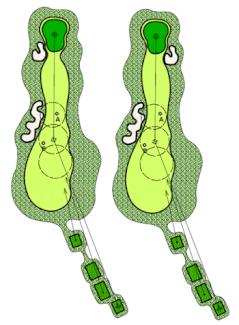Featured Golf News
Strategic Concepts - Outside Pinching Hazards
The "outside pinch hazard" is also commonly used to pinch the fairway just past the normal landing zone on the outside of the dogleg, as shown in the illustrations.

Strategically, the first version makes most sense - you hit an average-length drive and accept between one to three clubs more for an open front green and better approach. Or stronger players may choose a more aggressive drive to the narrower portion of the fairway, to shorten the approach, risking a recovery from the bunker or surrounding rough.
If the dogleg angles with the prevailing wind, it often forces longer players to curve the shots into the narrower, longer landing zone, adding skill requirement to mere length.
On the other version, there is little reason NOT to take the shortest route if it is also the easiest approach angle to the green. However, the inside route might have a disguised disadvantage, such as green contours rolling away from you from that direction.
Or, it might be an intentionally easy hole . The second arrangement is a useful design for the first and 10th holes. The dogleg-right accommodates a typical slice; green and fairway bunkers present good clubhouse views; and the hazards are on the left side. The fairway trap is beyond the normal landing zone, simultaneously challenging better players while minimizing impact on average players and facilitating fast play on the first hole of the round (and really, on any other hole it is used).
This arrangement also gives many players a comfortable feeling on the tee. They like "target bunkers" and "framing," and these type of bunkers do both, while visually "turning" the dogleg.
As a result, many architects commonly use - or potentially overuse - this arrangement for the visual appeal and comfort level it provides golfers.
This scheme presumes the hole has a gentle upslope just behind the fairway to naturally place the bunker. Most doglegs do follow the contour, and are banked up to the outside to help hold in tee shots. A few doglegs have "reverse slope" - falling away to the outside of the fairway, making this scheme hard to implement.
Jeffrey D. Brauer began his career as an apprentice in the Chicago area in 1977. His first project was Kemper Lakes, which shortly after hosted the 1989 PGA Championship. He formed GolfScapes in Arlington, Texas, in 1984. In the last 29 years he has designed and consulted on a wide spectrum of projects, ranging from partial renovations to international resorts. His recent work includes teaming with the design team of Pascuzzo and Pate on a remodel of the world-famous La Costa Resort & Spa in California, and renovations at Superior National Golf Course in Lutsen, Minn., and Mesquite Municipal Golf Course in Mesquite, Texas.
He has been a member of the American Society of Golf Course Architects since 1981, serving as President during its 50th Anniversary year in 1995-96. Jeff still studies the classic works - both old and new, and has played more than 75 of the best courses in the world.
Jeff gives many presentations and is a regular architecture columnist for many publications and websites, including Golf Course Industry and Cybergolf.com. He has also been a strong advocate for the "Tee it Forward" campaign and strives to make his courses fit the description of "fun to play every day."
Jeff's work has been spotlighted in most of the world's major golf magazines. Golf World ranked him as one of the top-20 golf course architects and Golf Inc. ranked him as the world's fourth-best value in golf architecture in 2010. Jeff's portfolio and reputation keep him at the forefront of desired designers for new courses, reconstruction and renovation projects. For more about Jeff, visit http://www.jeffreydbrauer.com/sites/courses/layout.asp?id=859&page=48451.
Story Options
 |
Print this Story |
